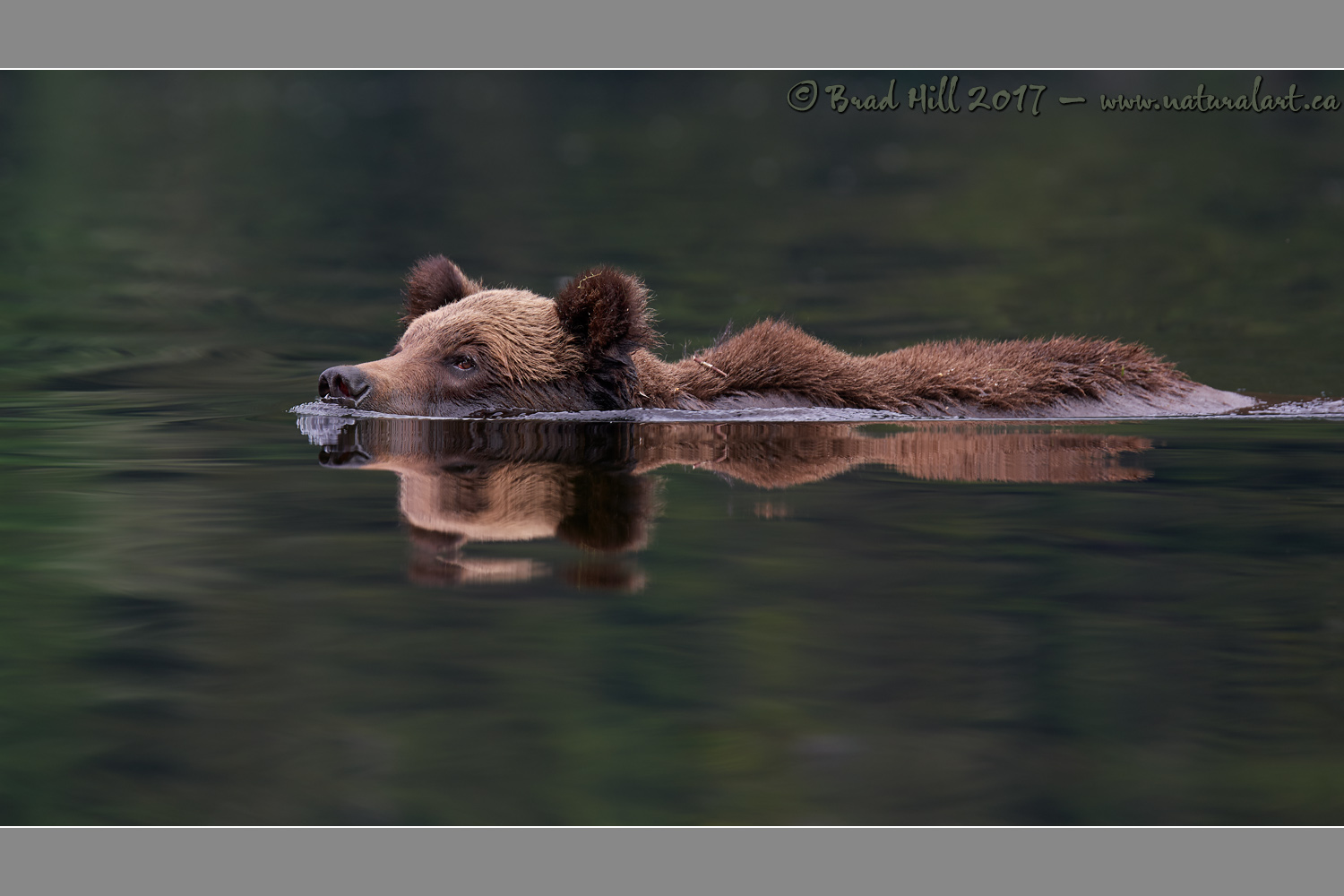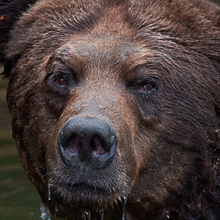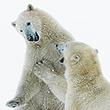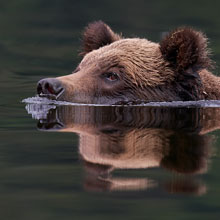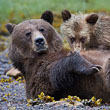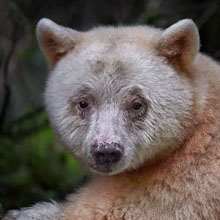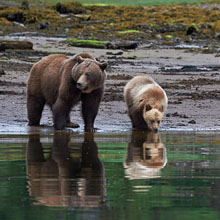Availability: Undetermined - Enquiries?
In the Field
Khutzeymateen Cruisin'. Khutzeymateen Inlet, Great Bear Rainforest, BC, Canada. May 25, 2017.
Sometimes...or maybe often...capturing simple, clean images of wildlife can be really challenging. This is true with almost any species you can think of, but it can be even tougher with the larger carnivores. I know of folks who have tried for YEARS to capture a shot of a grizzly swimming on calm water and yet still have nothing to show for it...the number of conditions that have to be "just right" (along with the challenging task of finding a swimming grizzly) is quite mind-boggling.
With all that in mind I'm almost embarrassed to say that THIS image was captured about 15 minutes into the first day of my first "Grizzlies of the Khutzeymateen" photo tours in 2017! We hadn't even fully gotten into the Khutzeymateen estuary when we saw this sub-adult male grizzly ease itself into the water (almost right in front of us!) and begin swimming (and on almost perfectly calm water!). Once the bear had crossed the inlet (and given us one more treat - a great shake as it climbed out of the water) and gone on its merry way I could do almost nothing but smile and shake my head. What dumb luck we had (along with horseshoes up our...)!
When I'm evaluating the "quality" of a lens through examining images shot in a field setting I always pay attention to both the sharpness of the image AND the quality of the out-of-focus (or OOF) zones. Lenses that make me happy (and that make me WANT to shoot with them) must be very sharp (of course) AND have smooth and almost "buttery" OOF zones. These two characteristics almost reinforce one another - if the OOF zones are smoothly blurred then the in-focus zones seem SHARPER (I usually refer to this as "apparent sharpness"). In MOST cases high-end prime super-telephotos (like 300mm and 400mm f2.8 primes as well as 500mm and 600mm f4 primes) outperform zoom lenses in this sharp in-focus zone/soft OOF zone balance - many new zooms are quite sharp, but usually their OOF zones don't match up well against the primes (especially some of the wider focal range zooms, like the Nikkor 80-400). But I have to say I am really impressed with the balance in the quality of the in- AND out-of-focus zones of the Sigma 120-300mm f2.8 Sport - it's right up there with the good primes.
Here's a larger (2400 pixel) version of this bold bruin (and a better size for evaluating image sharpness and the quality of the OOF zones):
• Khutzeymateen Cruisin': Download 2400 pixel image (JPEG: 0.7 MB)
ADDITIONAL NOTES:
1. This image was captured during one of my "Grizzlies of the Khutzeymateen" photo tour in the spring of 2017. Each year I offer trips into two different parts of the Great Bear Rainforest as well as one to photograph aquatic mammals and oceanscapes near the northern tip of Vancouver Island. And, in selected years, I also offer photo tours to locations to capture other highly sought-after subjects, such as various boreal owl species and wildlife of Canada's Arctic. Details about these trips can be found on the Photo Tours page of this website.
2. This image - in all resolutions - is protected by copyright. I'm fine with personal uses of them (including use as desktop backgrounds or screensavers on your own computer), but unauthorized commercial use of the image is prohibited by law. Thanks in advance for respecting my copyright!
3. Like all wildlife photographs on this website, this image was captured following the strict ethical guidelines described in The Wildlife FIRST! Principles of Photographer Conduct. I encourage all wildlife photographers to always put the welfare of their subjects above the value of their photographs.
Behind the Camera
Khutzeymateen Cruisin'. Khutzeymateen Inlet, Great Bear Rainforest, BC, Canada. May 25, 2017.
Digital Capture; Compressed RAW (NEF) 14-bit format; ISO 320.
Nikon D500 paired with Sigma 120-300mm f2.8 Sport lens @ 300mm (for an EFL of 450mm). Hand-held from moving Zodiac. OS on and in "OS1" mode, with OS1 stabilization customized to Moderate View mode; AF customized to Fast Priority AF.
1/500s @ f4; -0.67 stop compensation from "recommended" matrix-metered exposure setting.
At the Computer
Khutzeymateen Cruisin'. Khutzeymateen Inlet, Great Bear Rainforest, BC, Canada. May 25, 2017.
RAW Conversion to 16-bit TIFF using Phase One's Capture One Pro 10. Four raw variants (different versions of a single raw capture) processed, with the variants differing in exposure settings (0.6 stop total difference between the variants), shadow and highlight recovery settings, and noise reduction settings.
Further digital corrections on resulting 16-bit TIFF files using Adobe's Photoshop CC 2017 and Light Crafts Lightzone. Photoshop adjustments included compositing (blending) of the four output files from the raw converter, very minor exposure tweaks, and final selective sharpening for web output. Final tone-tweaking performed using LightZone's "tonemapper" tool.
Conservation
Khutzeymateen Cruisin'. Khutzeymateen Inlet, Great Bear Rainforest, BC, Canada. May 25, 2017.
Ten percent of the revenue generated by this image will be donated to Raincoast*.
Species Status in Canada**: Special Concern (May 2002).
While Grizzly Bears (Ursus arctos) are not technically listed as "Endangered" in Canada, they have been extirpated from most of their historical range. Grizzly Bears are far more sensitive to intrusion/disturbance in their habitat than are Black Bears and are being increasingly forced into marginal habitat by human encroachment. The Great Bear Rainforest along the central and northern coast of British Columbia is one of the last strongholds of the Grizzly Bear in Canada, and even this population is coming under increasing pressure.
On December 18, 2017 the government of British Columbia banned grizzly hunting across the entire province. This major conservation victory came after decades of tireless work by many dedicated conservationists and ecologists and, most importantly, it reflects the opinion of the vast majority of British Columbians. And, it means that AT LEAST while the current government remains in power grizzlies are finally "safe" in British Columbia.
Now that we've at least temporarily won the battle to save grizzlies in BC, it's time to re-focus our efforts toward protecting ALL of BC's carnivores, including Gray Wolves, Black Bears, Cougars, Wolverines, and more! Simply put, there are no ecological, economic, or ethical arguments supporting the trophy hunting of carnivores.
In a great first step towards ending the hunting of carnivores throughout BC the Raincoast Conservation Foundation has developed a program designed to protect ALL carnivores within the Great Bear Rainforest. Details about this program can be found on this page on Raincoast's website. Check it out and, better yet, make a donation to help Raincoast purchase the remaining commercial hunting tenures in the Great Bear!
*The Raincoast Conservation Society (and Foundation) is an effective and efficient organization that has been fighting for protection of this unique habitat. If you are looking for a meaningful way to contribute to the conservation of this amazing ecosystem, Raincoast will provide maximal "bang" for your conservation dollars.
**as determined by COSEWIC: The Committee on the Status of Endangered Wildlife in Canada












